Abstract
OBJECTIVE: Lead is a confirmed neurotoxicant, but the lowest blood lead concentration associated with deficits in cognitive functioning and academic achievement is poorly defined. The purpose of the present study was to examine the relationship of relatively low blood lead concentrations-especially concentrations <10 micrograms per deciliter (microg/dL)--with performance on tests of cognitive functioning in a representative sample of US children and adolescents. METHODS: The authors used data from the Third National Health and Nutrition Examination Survey (NHANES III), conducted from 1988 to 1994, to assess the relationship between blood lead concentration and performance on tests of arithmetic skills, reading skills, nonverbal reasoning, and short-term memory among 4,853 children ages 6-16 years. RESULTS: The geometric mean blood lead concentration for children n the study sample was 1.9 microg/dL; 172 (2.1%) had blood lead concentrations > or =10 microg/dL. After adjustment for gender, race/ethnicity, poverty, region of the country, parent or caregiver's educational level, parent or caregiver's marital status parent, serum ferritin level, and serum cotinine level, the data showed an inverse relationship between blood lead concentration and scores on four measures of cognitive functioning. For every 1 microg/dL increase in blood lead concentration, there was a 0.7-point decrement in mean arithmetic scores, an approximately 1-point decrement in mean reading scores, a 0.1-point decrement in mean scores on a measure of nonverbal reasoning, and a 0.5-point decrement in mean scores on a measure of short-term memory. An inverse relationship between blood lead concentration and arithmetic and reading scores was observed for children with blood lead concentrations lower than 5.0 microg/dL. CONCLUSION: Deficits in cognitive and academic skills associated with lead exposure occur at blood lead concentrations lower than 5 microg/dL.
Full text
PDF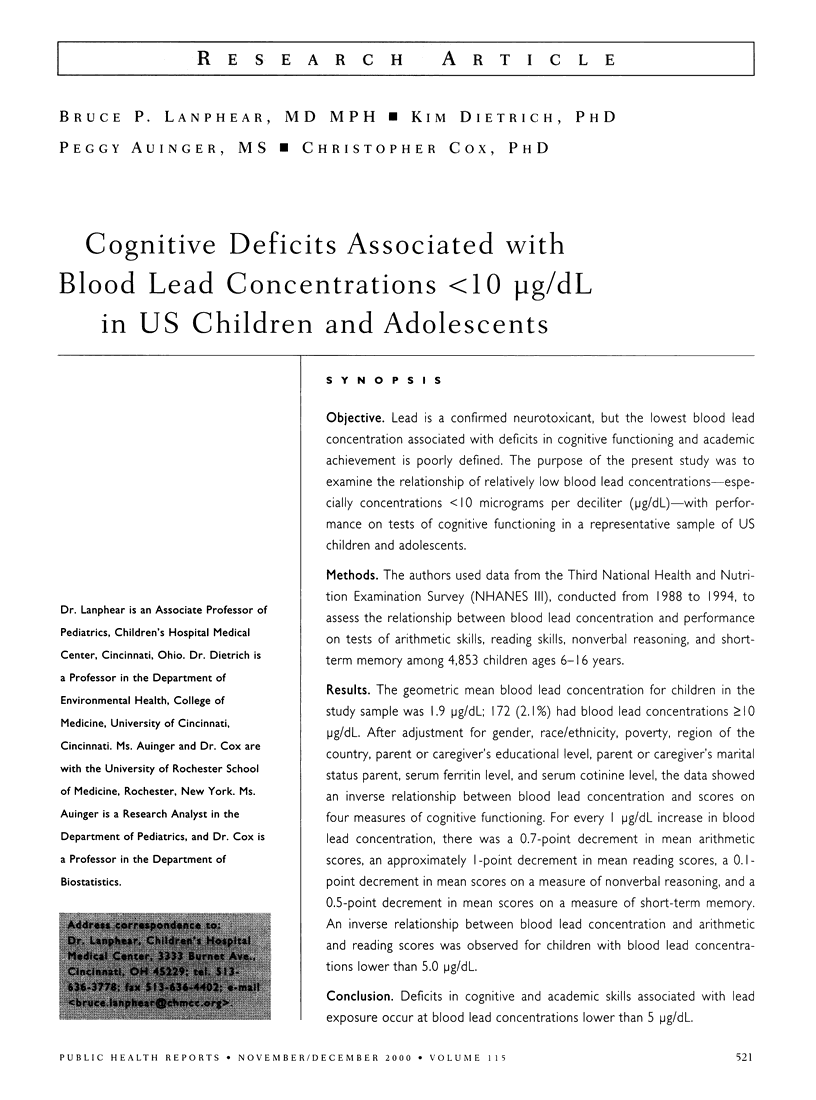
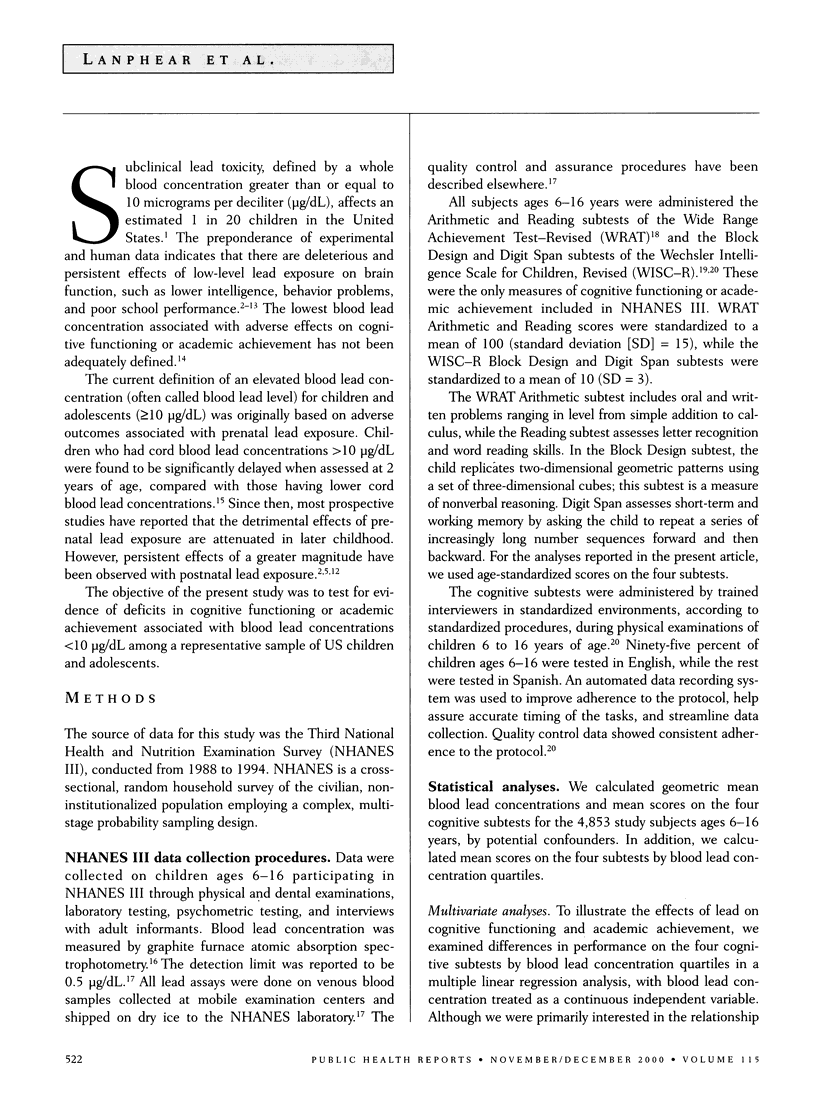


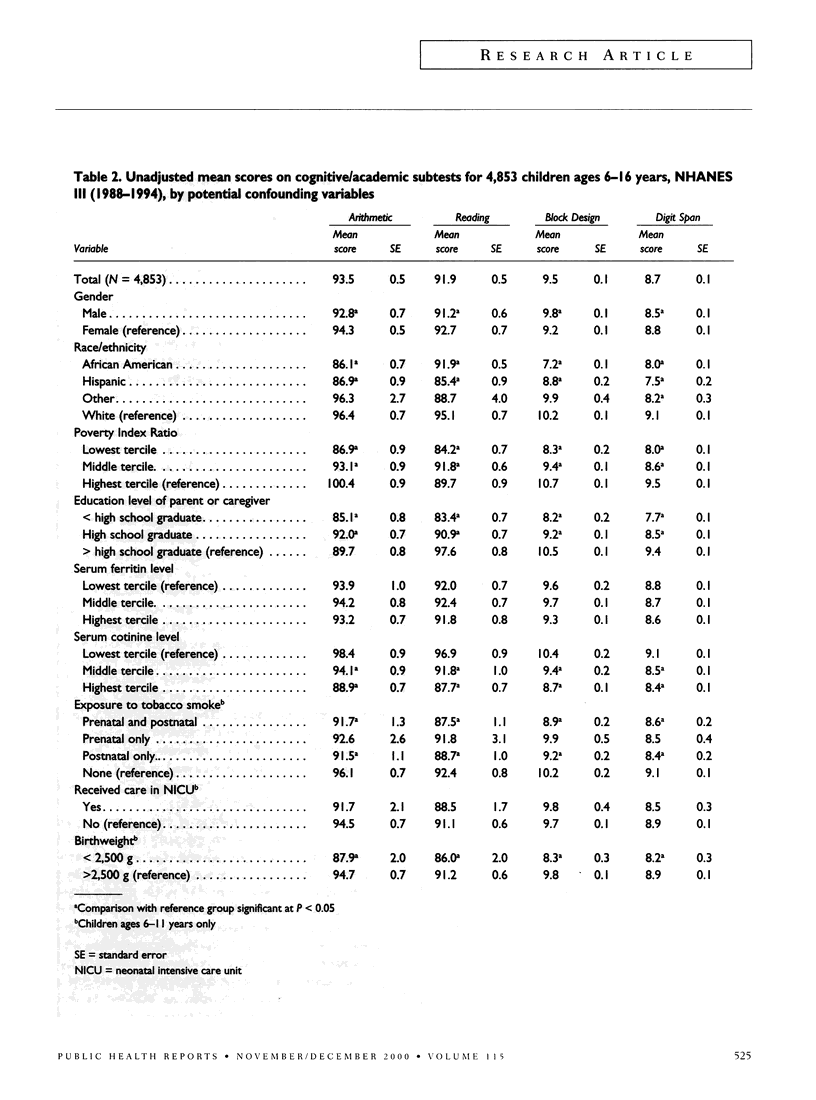
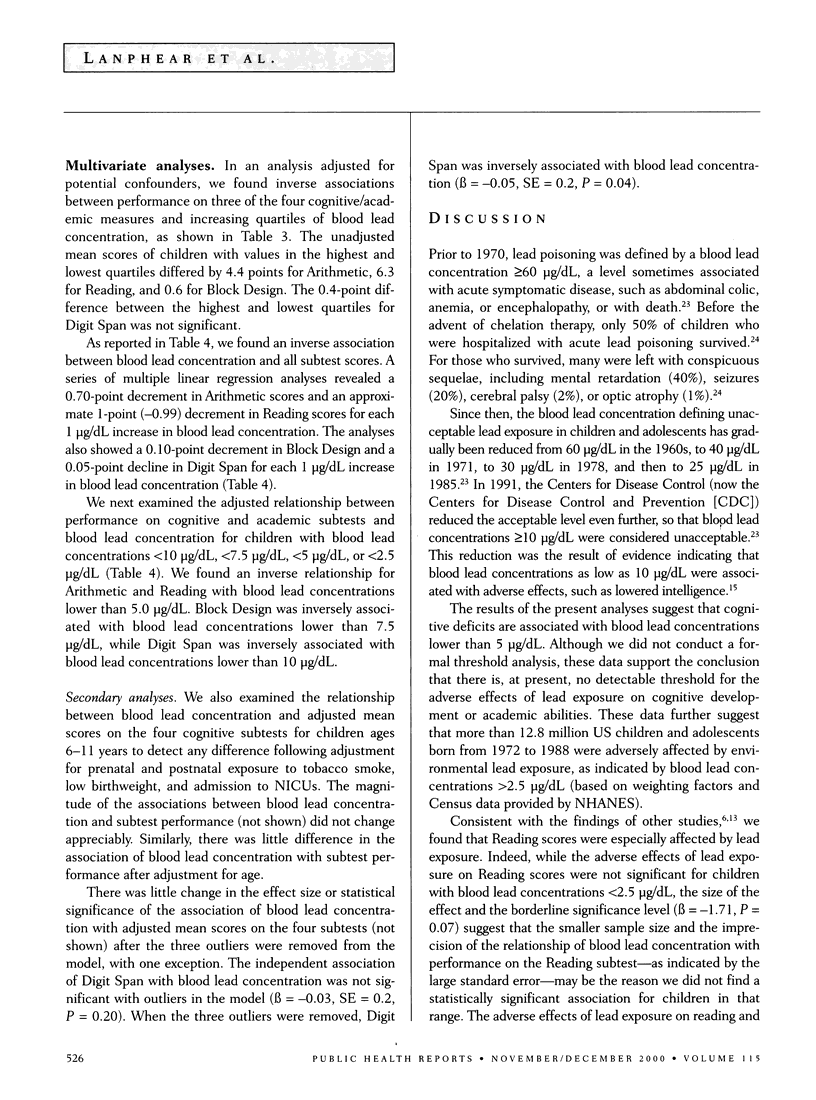
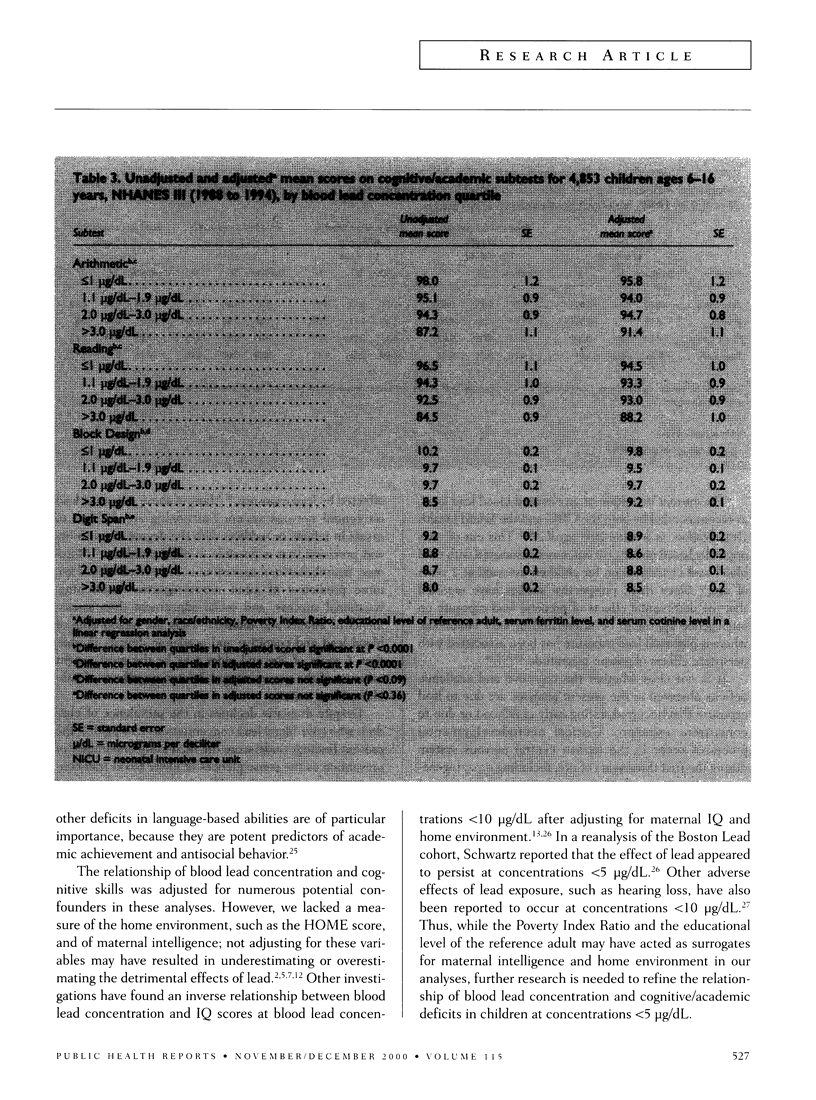
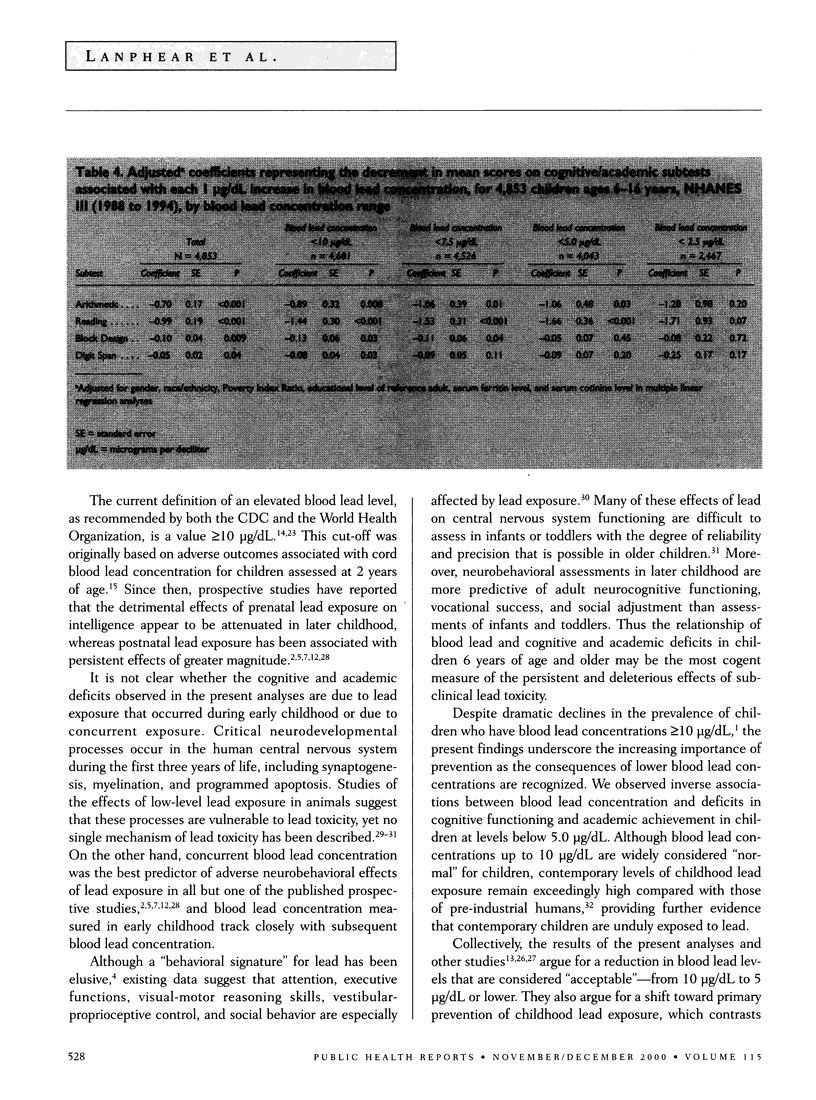
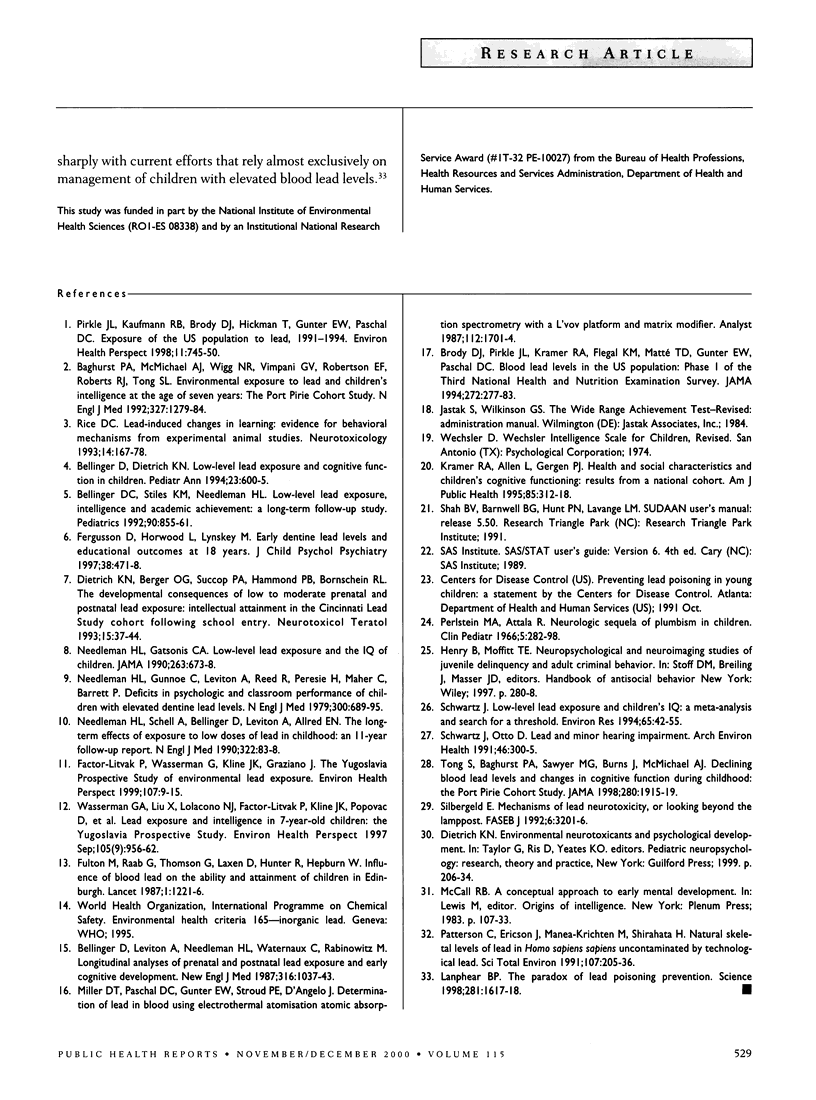
Selected References
These references are in PubMed. This may not be the complete list of references from this article.
- Baghurst P. A., McMichael A. J., Wigg N. R., Vimpani G. V., Robertson E. F., Roberts R. J., Tong S. L. Environmental exposure to lead and children's intelligence at the age of seven years. The Port Pirie Cohort Study. N Engl J Med. 1992 Oct 29;327(18):1279–1284. doi: 10.1056/NEJM199210293271805. [DOI] [PubMed] [Google Scholar]
- Bellinger D. C., Stiles K. M., Needleman H. L. Low-level lead exposure, intelligence and academic achievement: a long-term follow-up study. Pediatrics. 1992 Dec;90(6):855–861. [PubMed] [Google Scholar]
- Bellinger D., Dietrich K. N. Low-level lead exposure and cognitive function in children. Pediatr Ann. 1994 Nov;23(11):600–605. doi: 10.3928/0090-4481-19941101-08. [DOI] [PubMed] [Google Scholar]
- Bellinger D., Leviton A., Waternaux C., Needleman H., Rabinowitz M. Longitudinal analyses of prenatal and postnatal lead exposure and early cognitive development. N Engl J Med. 1987 Apr 23;316(17):1037–1043. doi: 10.1056/NEJM198704233161701. [DOI] [PubMed] [Google Scholar]
- Brody D. J., Pirkle J. L., Kramer R. A., Flegal K. M., Matte T. D., Gunter E. W., Paschal D. C. Blood lead levels in the US population. Phase 1 of the Third National Health and Nutrition Examination Survey (NHANES III, 1988 to 1991) JAMA. 1994 Jul 27;272(4):277–283. doi: 10.1001/jama.272.4.277. [DOI] [PubMed] [Google Scholar]
- Dietrich K. N., Berger O. G., Succop P. A., Hammond P. B., Bornschein R. L. The developmental consequences of low to moderate prenatal and postnatal lead exposure: intellectual attainment in the Cincinnati Lead Study Cohort following school entry. Neurotoxicol Teratol. 1993 Jan-Feb;15(1):37–44. doi: 10.1016/0892-0362(93)90043-n. [DOI] [PubMed] [Google Scholar]
- Factor-Litvak P., Wasserman G., Kline J. K., Graziano J. The Yugoslavia Prospective Study of environmental lead exposure. Environ Health Perspect. 1999 Jan;107(1):9–15. doi: 10.1289/ehp.991079. [DOI] [PMC free article] [PubMed] [Google Scholar]
- Fulton M., Raab G., Thomson G., Laxen D., Hunter R., Hepburn W. Influence of blood lead on the ability and attainment of children in Edinburgh. Lancet. 1987 May 30;1(8544):1221–1226. doi: 10.1016/s0140-6736(87)92683-3. [DOI] [PubMed] [Google Scholar]
- Kramer R. A., Allen L., Gergen P. J. Health and social characteristics and children's cognitive functioning: results from a national cohort. Am J Public Health. 1995 Mar;85(3):312–318. doi: 10.2105/ajph.85.3.312. [DOI] [PMC free article] [PubMed] [Google Scholar]
- Lanphear B. P. The paradox of lead poisoning prevention. Science. 1998 Sep 11;281(5383):1617–1618. doi: 10.1126/science.281.5383.1617. [DOI] [PubMed] [Google Scholar]
- Miller D. T., Paschal D. C., Gunter E. W., Stroud P. E., D'Angelo J. Determination of lead in blood using electrothermal atomisation atomic absorption spectrometry with a L'vov platform and matrix modifier. Analyst. 1987 Dec;112(12):1701–1704. doi: 10.1039/an9871201701. [DOI] [PubMed] [Google Scholar]
- Needleman H. L., Gatsonis C. A. Low-level lead exposure and the IQ of children. A meta-analysis of modern studies. JAMA. 1990 Feb 2;263(5):673–678. [PubMed] [Google Scholar]
- Needleman H. L., Gunnoe C., Leviton A., Reed R., Peresie H., Maher C., Barrett P. Deficits in psychologic and classroom performance of children with elevated dentine lead levels. N Engl J Med. 1979 Mar 29;300(13):689–695. doi: 10.1056/NEJM197903293001301. [DOI] [PubMed] [Google Scholar]
- Needleman H. L., Schell A., Bellinger D., Leviton A., Allred E. N. The long-term effects of exposure to low doses of lead in childhood. An 11-year follow-up report. N Engl J Med. 1990 Jan 11;322(2):83–88. doi: 10.1056/NEJM199001113220203. [DOI] [PubMed] [Google Scholar]
- Patterson C., Ericson J., Manea-Krichten M., Shirahata H. Natural skeletal levels of lead in Homo sapiens sapiens uncontaminated by technological lead. Sci Total Environ. 1991 Sep;107:205–236. doi: 10.1016/0048-9697(91)90260-l. [DOI] [PubMed] [Google Scholar]
- Pirkle J. L., Kaufmann R. B., Brody D. J., Hickman T., Gunter E. W., Paschal D. C. Exposure of the U.S. population to lead, 1991-1994. Environ Health Perspect. 1998 Nov;106(11):745–750. doi: 10.1289/ehp.98106745. [DOI] [PMC free article] [PubMed] [Google Scholar]
- Rice D. C. Lead-induced changes in learning: evidence for behavioral mechanisms from experimental animal studies. Neurotoxicology. 1993 Summer-Fall;14(2-3):167–178. [PubMed] [Google Scholar]
- Schwartz J. Low-level lead exposure and children's IQ: a meta-analysis and search for a threshold. Environ Res. 1994 Apr;65(1):42–55. doi: 10.1006/enrs.1994.1020. [DOI] [PubMed] [Google Scholar]
- Schwartz J., Otto D. Lead and minor hearing impairment. Arch Environ Health. 1991 Sep-Oct;46(5):300–305. doi: 10.1080/00039896.1991.9934391. [DOI] [PubMed] [Google Scholar]
- Silbergeld E. K. Mechanisms of lead neurotoxicity, or looking beyond the lamppost. FASEB J. 1992 Oct;6(13):3201–3206. doi: 10.1096/fasebj.6.13.1397842. [DOI] [PubMed] [Google Scholar]
- Tong S., Baghurst P. A., Sawyer M. G., Burns J., McMichael A. J. Declining blood lead levels and changes in cognitive function during childhood: the Port Pirie Cohort Study. JAMA. 1998 Dec 9;280(22):1915–1919. doi: 10.1001/jama.280.22.1915. [DOI] [PubMed] [Google Scholar]
- Wasserman G. A., Liu X., Lolacono N. J., Factor-Litvak P., Kline J. K., Popovac D., Morina N., Musabegovic A., Vrenezi N., Capuni-Paracka S. Lead exposure and intelligence in 7-year-old children: the Yugoslavia Prospective Study. Environ Health Perspect. 1997 Sep;105(9):956–962. doi: 10.1289/ehp.97105956. [DOI] [PMC free article] [PubMed] [Google Scholar]


